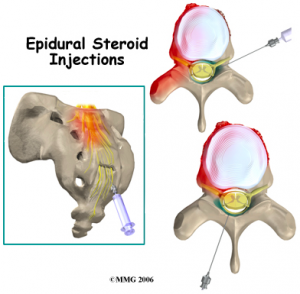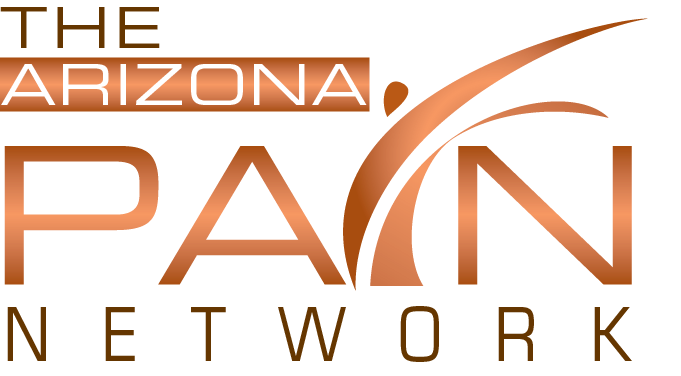What exactly is spinal stenosis?
Spinal stenosis is a condition that results in narrowing of the area around the spinal cord and where the nerve roots exit from it. As a result of this narrowing, nerve roots get pinched and pain may result from the compressed nerves.
get pinched and pain may result from the compressed nerves.
Typically the compression occurs at numerous levels of the spine and it may not be symmetric from left to right. Spinal stenosis affects millions of people in America.
Who typically gets spinal stenosis?

Bone Spurs and Soft Tissue Overgrowth pinch nerves in Spinal Stenosis
The condition usually results from arthritis where the body is attempting to stabilize a degenerative joint by growing bone and extra soft tissue. Since the joints around the spine called the facet joints are losing cartilage, the body is not very good at keeping up with that loss.
The body is great at making extra bone and soft tissue, though, which in this case does not help. It actually hurts the individual by over growing the area and compressing on nerve roots. Since multiple areas typically suffer from arthritis, spinal stenosis often occurs at numerous levels.
The typical individual who suffers from spinal stenosis is in a relatively older age group. This typically means from the 50’s and up, with the chances of suffering from spinal stenosis increasing with each decade of aging.
There are also instances of congenital problems leading to spinal stenosis such as in dwarfism. In those cases the person may be much younger and suffer from the problem. However the vast majority occurs with typical wear and tear degenerative arthritis of the spine leading to spinal stenosis.
Call (602) 507 – 6550 to schedule your Appointment TODAY!

What are the typical symptoms seen with spinal stenosis?
Patients who have spinal stenosis typically have an aching pain that radiates into the buttock area and around the hip. In fact, symptoms of spinal stenosis may often be mistaken for a hip joint problem. At times, the pain and aching may radiate down one or both legs into the thigh area, and sometimes past the knee.
When pain sparks up in the lower extremities as a result of spinal stenosis, it is termed neurogenic claudication. It results from compression on the spinal nerves not receiving enough oxygen and pain resulting. It is important to delineate between neurogenic claudication which is coming from spinal stenosis and vascular claudication which is coming from a blood vessel problem.
Vascular claudication ends up causing individuals a cramping type of pain, typically in the calf area from a specified amount of ambulation that gets better with rest. Neurogenic claudication is more positional related and the patient often feels better if they lean forward as that opens up the areas where the nerve root is being compressed. It does not typically occur as a cramping type pain during a set distance of walking as the vascular type.
How is spinal stenosis diagnosed?
Due to the fact that stenosis is so common, it is not an extremely difficult diagnosis. History and physical examination will usually elicit a hint of stenosis being present, and an MRI will often show the areas of compression.
X-rays only show spinal alignment and arthritis, not the spinal soft tissues. So for stenosis the best imaging study is an MRI. X-rays of the hip joint may help substantially if arthritis is suspected on exam.
If there is suspicion of vascular disease, then doppler studies of the lower extremities can elucidate whether the person suffers from both vascular and neurogenic claudication or one in particular. In addition, if it is unclear if the patient suffers from simply stenosis or pain from hip joint arthritis, an injection of numbing medicine into the hip can delineate between the two with the patient then describing how much relief occurs.
What treatments are available for spinal stenosis?
Spinal stenosis is a quality-of-life condition. It’s not going to ever be fatal for an individual, and surgery for the condition is an elective decision. Therefore the optimal outcome is to avoid surgery with nonoperative treatment measures.
These treatment measures consist of the following; anti-inflammatory medications such as ibuprofen and naproxen, Tylenol, and in acute flareup situations narcotic medication. There have also been some studies looking at neurologic agents such as gabapentin and Lyrica which may work well too (Yaksi et al, 2007 Spine).
Physical therapy and or chiropractic treatment can benefit the symptoms of spinal stenosis. This may help decompress pinched nerves and strengthen up the muscles around the spine to take some pressure off of it, but it is not going to fix the problem. Spinal decompression therapy has also been shown to nicely relieve the symptoms of spinal stenosis as well.
Call (602) 507 – 6550 to schedule your Appointment TODAY!

Interventional treatments by pain management doctors such as epidural steroid injections work well for the symptoms of spinal stenosis (Delport et al, 2004, Arch Phys Med Rehab). There is an inflammatory component to the resulting pain as the nerve roots are being compressed. And the steroids act as large anti-inflammatory agents to relieve that pain.

Epidural Injections work well for spinal stenosis over 75% of the time.
Epidural steroid injections may be performed as an outpatient with several different types being performed. Since a typical patient with spinal stenosis has multiple levels of nerve root compression, often times a different type of the usual epidural injection called a caudal epidural injection works well.
A caudal epidural steroid injection is able to disseminate the cortisone medication to multiple levels of the spine allowing it to bathe nerve roots that are being compressed at multiple levels.
Outcomes from epidural steroid injections for spinal stenosis have been shown to be excellent in multiple research studies. Typically satisfactory results can be achieved in over 75% of patients (Botwin et al, 2002 Am J Phys Med Rehabil). If the results wear off after a few months, the injections may be repeated.
If all of the conservative measures fail and as a quality-of-life decision an individual desires surgical treatment, the typical surgery is a laminectomy procedure where the compressive structural elements are removed. Whether or not a spinal fusion is added to the procedure is controversial and that should be discussed with the specific surgeon involved.
If you suffer from spinal stenosis and would like comprehensive nonsurgical pain management treatment, Arizona Pain Specialists can help. Arizona Pain has clinics throughout the Valley and accepts all major insurance as well as Medicare and some of the AHCCCS plans.
Call (602) 507 – 6550 to schedule your Appointment TODAY!

![]()


 get pinched and pain may result from the compressed nerves.
get pinched and pain may result from the compressed nerves.
